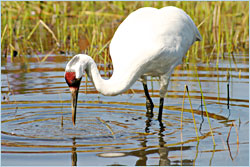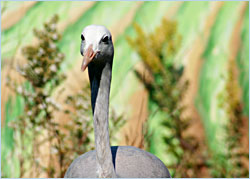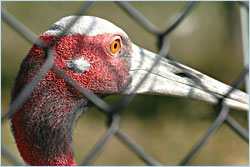Cranes of Wisconsin
Near Wisconsin Dells, a global village of birds lives, loves and thrives.

© Beth Gauper
In Wisconsin, the rarest birds in the world live not far from the Dells.
Not just any birds, but cranes — the tall, elegant birds of art and myth.
In ancient Japan, cranes could grant wishes. In India, they're omens of good fortune.
It's good fortune they survive at all, with their habitats shrinking around the world. Near Baraboo, all 15 species live at the International Crane Foundation, founded in 1973 by George Archibald and Ron Sauey on Sauey's parents' horse farm.
The first thing visitors to this sanctuary notice is that, even though the cranes live in pens, they rule the roost.
For birds, cranes have outsized personalities. They're loud, physical and intense, often responding to visitors in startling ways.
If you're not prepared, the piercing shriek of a sarus crane, the tallest flying bird in the world at 6 feet, will make you jump out of your shoes.
Red-crowned cranes growl, and many cranes stalk toward visitors with their neck feathers flared like a cobra — threat behavior, used by both males and females.
But they're not always so fierce. The last time I visited, we began at the enclosure of a South African grey crowned crane, whose head feathers actually are the color of corn tassels.
"You can tell she's very happy," said our guide Bridget Amulike, who had come from Tanzania to learn about the birds. "Her golden crown is very tall."
As if on cue, the crane jumped up in excitement and spread her wings. With the red "tie" at her throat, she looked like a Japanese watercolor come to life.
But this crane likes people too much, and her male mate not at all. Result: no chicks.

© Beth Gauper
"She likes people because that's what she saw when she hatched," Bridget said. "So we can learn from these mistakes."
The Crane Foundation has used that lesson to help rebuild the population of whooping cranes, which were hunted for food and feathers and had dwindled to 22 by 1941.
Wearing crane costumes so chicks don't imprint on humans, its biologists raised baby cranes. In 2001, they successfully trained the cranes to follow an ultralight to Florida, re-establishing the traditional winter migration. They're still doing it every year, and the flock of wild birds has grown.
But whoopers are a little too much like humans in another way: If they don't like their mates, they won't produce eggs.
"There are 600 now, but 600 birds is not enough," Bridget said. "They're still very, very endangered."
We moved on to the blue crane from South Africa and the black crowned crane from West Africa, where they are domesticated and also killed for use in medicine.
Demoiselle cranes are native to the steppes of Russia, but received their name from Marie Antoinette when they were brought to France. They're the smallest cranes, only 3 feet tall and four to seven pounds.
They're also the daintiest in appearance, with a pure-white fringe of feathers around the backs of their heads.
Eurasian cranes are familiar to Europeans, who see them as they fly to spend the winter in Spain and northern Africa.
"If you have a swimming pool in Europe, you can expect a crane to come use it, too," Bridget said.

© Beth Gauper
Sandhill cranes are most familiar to Midwesterers, who often hear their loud, rattling calls and see them feeding in corn fields.
At the sanctuary, both the male and female were standing at the fence, gazing intently at the visitors with their orange eyes; plexiglass prevented contact from their long beaks.
Cranes can be scary. In her enclosure, a white-naped crane was bugling more like an elephant than a bird, and Bridget translated: "Get away, get away, this is my territory."
"She's alone because the male is very aggressive," Bridget said. "If you pair him with a female, he usually attacks, and he even managed to kill one female."
Red-crowned cranes are named not for red feathers, but for the blood that rushes through the back of their heads when they're excited. The pair we saw were indeed excited, thrusting their necks in the air, beaks straight up, and spreading wings as they honked to the heavens.
All cranes do unison calling, and they also dance, which is part of courtship but also done to "thwart aggression, relieve tension and strengthen the pair bond."
It's a little more peaceful to watch the whooping cranes, who live in a marsh, and the wattled cranes, who live in a low meadow that resembles their African homeland.
After traveling around the world via crane — they live on every continent except South America and Antarctica — visitors can wind down by walking the sanctuary's serene nature trails.
They're loveliest in spring, when they're lined with wildflowers, and in autumn, when the maples and oaks sport fall colors.
Trip Tips: International Crane Foundation
Getting there: From Wisconsin Dells or I-94/90, take the U.S. 12 exit south to County Road BD and head east on Shady Lane Road.
Hours and admission: It's open daily from May through October. Admission is $12.50, $6 for ages 6-17.
Tours: Guided public tours are given at 10 a.m. and 1 p.m. daily from Memorial Day to Labor Day and weekends only in May and September-October.
Nearby attractions : This part of Wisconsin is famous for having produced so many naturalists, including John Muir, whose boyhood farm now is a county park, and Aldo Leopold, whose shack is along the Wisconsin River.
Visiting them makes a fun road trip. For more, see Pilgrimage to the Baraboo Hills.
The Crane Foundation also is very close to Devil's Lake State Park and, of course, the Wisconsin Dells.
Baraboo is a destination for Circus World. For more, see Baraboo's gilt complex.